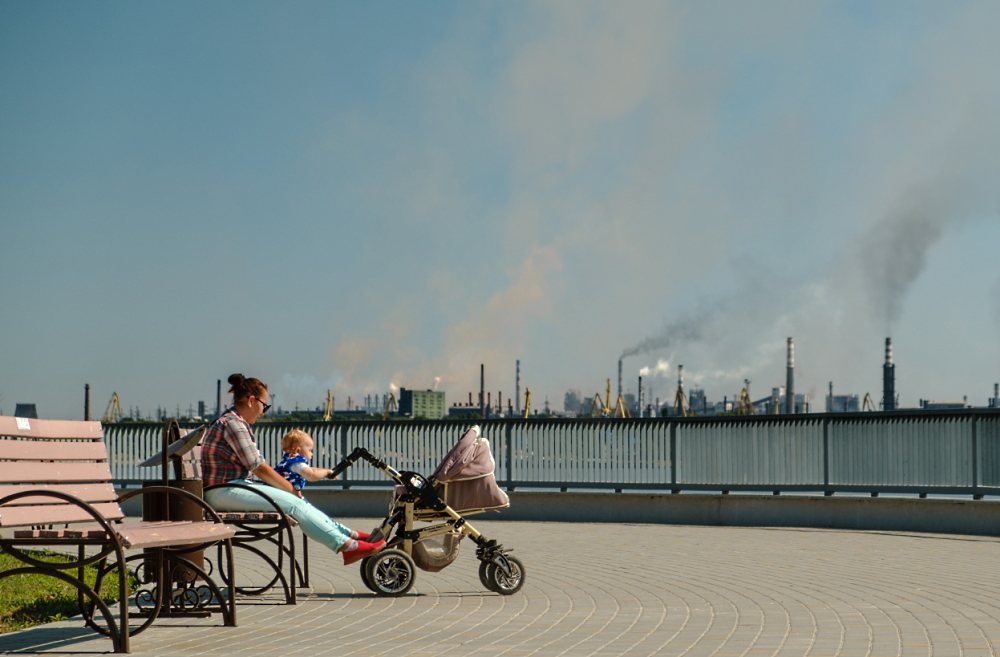The coughing fits that kept William Bond and his parents up all night started when he was 12 months old. When he was five, after visiting several pediatricians, one of them finally diagnosed him with asthma.
The now six-year-old Texan’s symptoms — coughing, wheezing, acute breathlessness caused by swollen, mucus-filled airways — has worsened amid an uptick in air pollution, pollen, mold and hurricanes in the Bond family’s densely populated, subtropical city.
“We had always heard that it was bad to be within three miles of a freeway, and it’s kind of hard to be outside of that range in Houston,” said Emily Bond, the boy’s mom. “So, we made a conscious decision — even though we really love this city — to get out. In our minds, the hurricane seasons aren’t going to get better. The flooding won’t get better.”
Aware of the effects of those environmental realities, the American Medical Association this month declared climate change a public health crisis that threatens everyone’s well-being.
 Regarding asthma, six million of the nation’s children have been diagnosed with that disorder, according to the U.S. Centers for Disease Control and Prevention. More than 40% of Americans, or more than 137 million people, live in places with unhealthy air, according to the American Lung Association’s 2022 State of the Air report. That’s 11.1 million more people, since the association’s 2021 tally, who now reside in locales where air pollution, which fuels hurricane-causing climate change, has been linked to an increased risk of heart and lung disease, stroke, cancer and frequently flaring asthma.
Regarding asthma, six million of the nation’s children have been diagnosed with that disorder, according to the U.S. Centers for Disease Control and Prevention. More than 40% of Americans, or more than 137 million people, live in places with unhealthy air, according to the American Lung Association’s 2022 State of the Air report. That’s 11.1 million more people, since the association’s 2021 tally, who now reside in locales where air pollution, which fuels hurricane-causing climate change, has been linked to an increased risk of heart and lung disease, stroke, cancer and frequently flaring asthma.
“There are certain cities, that if you’re really severely allergic, you just don’t move to,” said Dr. Rosalyn Baker, a pediatric allergist-immunologist who previously practiced in the Washington, D.C. area.
In 2015, she’d joined a group of physicians on Capitol Hill pushing for changes to the Clean Air Act to better protect their patients. In addition to the physical damage, they cited the high cost — as much as $40,000 a year per patient — of treating asthma.
“The majority of childhood asthma is allergic asthma, meaning there’s something in the environment that the child is having an allergic reaction to. And that allergic reaction can be manifested as asthma,” explained Dr. Stephanie Lovinksy-Desir, a pediatric lung specialist in New York City and American Lung Association spokesperson.
In the United States, people of color and those of varying race who live in lower-income communities are more likely to live in a county with bad air quality, according to the lung association’s report. Among American children, those of Puerto Rican descent, whether on the island or on the U.S. mainland, have the highest rates nationwide, with one in four developing asthma in their lifetime. That compares to one in five Black children and roughly one in 10 each among white children and Mexican American children.
Rates of death from asthma are also highest among Puerto Rican children and non-Latinx Black children.
How asthma flares affect everyday life
Asthma flares come at a cost for young people, and not just in terms of medical treatment. Asthma caused 5.2 million lost school days annually between 2008 and 2013, according to a 2018 federal Centers for Disease Control and Prevention report.
Plus, as hotter temperatures prolong the pollen-filled allergy season, it’s more likely that children with asthma will have to remain indoors and sedentary, which poses other health risks, said Lovinsky-Desir, who treats childhood asthma.
Related Stories
• After a win for U.S. climate change education, classroom implementation is off to a slow start
• What are green jobs and how can I get one? 5 questions answered about clean energy careers
• Latino activism leads in grassroot efforts on climate change
• UN report: Today’s children will see massive increase in climate extremes
• Youth and climate change: How a generation is adapting while fighting for their future
Alex Mayer, director of the Center of Environmental Resource Management at the University of Texas in El Paso, said there are multiple reasons the Rio Grande is drying up. He has spent his career researching water management and has worked on many projects dealing with water scarcity, human infrastructure, and climate change.
Lovinsky-Desir’s current research is on the effects of air pollution on children’s physical activity, particularly at a time when one in five U.S. children have obesity, according to the CDC, and one in six are overweight according to the National Institutes of Health – an all-time high.
“There are a lot of children who want to be active but end up on the sidelines because of their [asthma] flares,” Lovinsky-Desir added. Those sidelined youth, she said, should see a lung specialist, whereas pediatricians can manage most asthma cases.
Also, parents can play a vital role in asthma management and in the prevention of attacks, Lovinsky-Desir said. “When you’re checking if you should wear your coat or bring an umbrella, you can check what the air quality is like. Maybe you’ll play indoors instead.”
Being driven indoors due to poor outdoor air quality, which is available on sites such as airnow.gov, however, has the added risk of even more exposure to the common indoor triggers, such as mold, dust and rodents.
“When I would do allergy skin testing in my practice,” Baker said, “I could tell what the person’s occupation was based upon their results. If I saw a strong, positive test for mice, I knew that person was probably a school teacher, or worked in an old building.”
Mask-wearing during COVID-19 reduced asthma flares
Surprisingly, despite the fears that COVID-19 pandemic would trigger more asthma flares, Lovinsky-Desir and other lung specialists actually saw fewer cases of asthma flares during 2020 and early 2021. She suspects it was due to mask-wearing.
“The most important thing that masks did was reduce transmission of viruses,” said Lovinsky-Desir. “We weren’t seeing the other viruses that typically cause asthma exacerbations, especially during the peak fall viral season where we tend to see lots of kids getting sick with asthma.”
The new COVID precautions surrounding air flow that many school systems have adopted may also help keep asthma at bay, Lovinsky-Desir said.
Baker still suggests that parents work with their child’s physician or nurse to create an asthma action plan guiding which medicines to give when a flare starts. While safeguarding their homes against roaches and rodents, whose dander and urine can trigger an asthma flare, and encourage schools to stay current with pest control.
Coal-burning and large-scale farming can trigger allergies, asthma
Unhealthy air doesn’t just affect people with asthma or who live in cities. It also triggers allergies in youth with no previous history of them. In rural communities, the allergy-triggering and/or asthma-aggravating emissions from burning coal as fuel and large-scale farming, as examples, also are a problem. A study published in 2020 in Nature Energy showed that when four Louisville coal power plants closed, asthma outcomes in that area improved.
The federal Clean Air Act, first passed in 1970, created state-by-state air quality standards that were aimed at regulating and reducing vehicular and industrial emissions. The act has been amended several times since. In 2020, under the Trump Administration, the Environmental Protection Agency filed a guidance memorandum that loosened the restrictions, but then rescinded this in 2021 under the Biden Administration.
However, opponents of clean air legislation have expressed concerns abouts its effect on jobs and the energy industry. In a September 2021 letter addressed to the Committee on Energy & Commerce, opposing the Clean Electricity Performance Program, Michelle Bloodworth, president and CEO of American Power, a trafe group, wrote: “Coal-fired generation and its supply chain are responsible for 185,000 jobs, which would be lost if coal-fired electricity is eliminated by the CEPP.”
In August of 2021, President Joseph Biden announced his steps toward lowering emissions by encouraging the production of more electric cars and trucks by 2030.
Earlier in 2022, more than 30 airlines said they were developing carbon offsetting programs.
And last month, the Biden-Harris Administration announced an investment of more than $2.3 billion to cut U.S. carbon pollution.
Physician: Parents should push for air quality standards
Baker encourages parents of children with asthma who are joining advocacy efforts around climate change to do their research to ensure that the groups are not receiving funding from the same industries that pollute the air.
Given her tough experiences with her son’s asthma, Bond gets frustrated by those who dismiss the realities of climate change and its negative impacts on health.
The concept of climate change “might not exactly align with what you’ve been told,” Bond said, who initially planned to move to North Carolina, but due to job opportunities, chose to stay within a less-dense area of Texas. “Whatever your parents told you twenty years ago, just take a moment to consider that. There might be more than just opinion behind there. There might actually be science behind it.”
***
New Jersey-based emergency medicine physician and journalist Dr. Tyeese Gaines is a content producer-commentator for Black America’s Health. She has reported for MSNBC and NBCBLK, and was medical editor for The Grio.




























